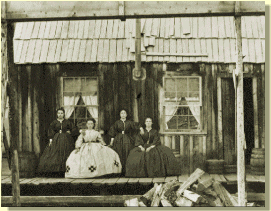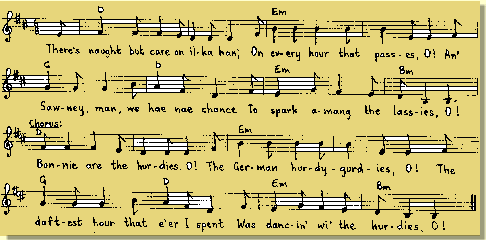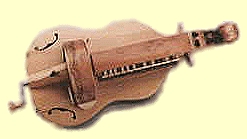Hurdy Gurdy Girls
![]()
Hurdy Gurdy Girls
Although the Barkerville saloons already had women entertainers, much excitement was caused in the summer of l865 when there arrived from San Francisco an organized group of dancing partners, complete with musicians.

|
|
BC ARCHIVES G-00817 Hurdy Gurdy Girls |
The girls danced with the miners for a dollar a dance to the rhythms made by two fiddlers who reportedly sang loud so the music could be heard above the noise of the stomping feet.
Starved of women's company and faced with the troupe's determination to deal in nothing but dance steps, the men developed a style of dancing that both surprised and exhausted their partners.
The main point of this step, as described by those who were there, was for the man to lift his partner repeatedly as high as he could off the floor, at the same time swinging her feet aloft.

|
|
Sheet Music Song about the "The Hurdy-Gurdy Girls" |
The girls had come originally from continental Europe noted in the song "Bonnie Are the Hurdies, O!," the "German" hurdy-gurdy girls.
What is a "hurdy-gurdy?" Here is a two part guess.
1) First, the fiddlers may have on occasion used the genuine hurdy-fiddle, a mechanical contrivance used at that time by street musicians; or perhaps the fiddling, under the circumstances, sounded just as if it were done on those crude instruments.

|
| A Hurdy Gurdy |
2) Second,the overall effect of the dance may have been a"hurdy-gurdy," which in both English and Scottish dialect is "an uproar, a disorder."
The Sentinel (the local newspaper) has left us a description of the "hurdy":
HURDY GURDY DAMSELS"There are three descriptions of the above-named "ladies" here; they are unsophisticated maidens of Dutch (sic) extraction, from 'poor but honest parents' and normally speaking, they really are not what they are generally put down for.
They are generally brought to America by some speculating, conscienceless scoundrel of a being commonly called a 'Boss Hurdy.'
This man binds himself in his service until he has received about a thousand percent for his outlay.
The girls receive a few lessons in the Terpsichorean art, are put into a kind of uniform, generally consisting of a red waist, cotton print skirts and a half-mourning headdres resembling in shape the top-knot of a male turkey; this uniform gives them a gortesque (sic) appearance.
Few of them speak English but they soon pick up some popular vulgarisms, and like so many parrots they use them indiscriminately on all occasions; if you bid one of them good morning your answer will likely be 'itsh sphlaid out' or 'you bet your life.'
The Hurdy style of dancing differs from all other schools. If you ever saw a ring of bells in motion, you have the exact position these young ladies are put through during the dance; the more muscular the partner, the nearer the approximation of the ladies pedal extremities to the ceiling, and the gent who can hoist his 'gal' the highest is considered the best dancer; the poor girls as a general thing earn their money very hardly."
Quoted from: "Barkerville: A Guide to the Fabulous Cariboo Gold Camp." Canadian WestMagazine ñ Special Issue. Bruce Ramsey. No.7. 1987. Langley, B.C.: Sunfire Publications. p.26-27.
Songs of the Pacific Northwest. Ed. Philip J Thomas. Music Transcription and Notation by Shirley A. Cox. Saanichton, B.C.: Hancock House Pub (1979.) p.44-46.



|
Last updated 31 August 1998. Produced by Industrial Art Internet Group Ltd. © 1998-1999 |
